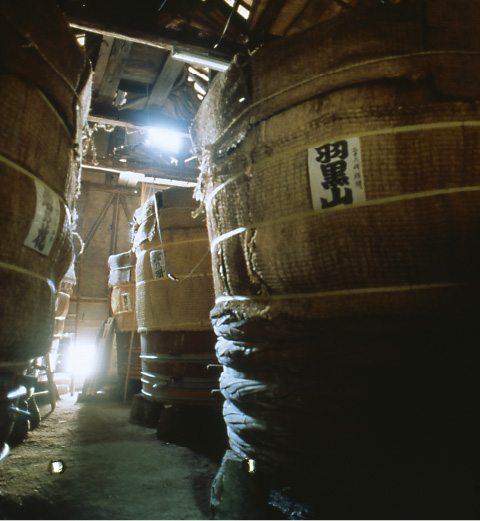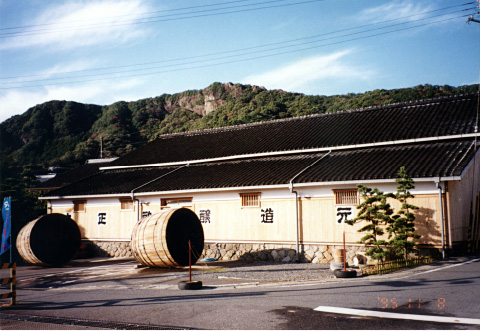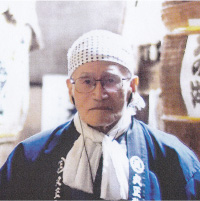As a Vinegar-Making Craftsman
Facing Vinegar Production-Craftmanship-
Source: This article was originally published in the Monthly Food Chemical released in February 2011. Information is at the time of publishing and may change according to circumstances.
1.Resumption of Vinegar Production After the War
I graduated from business high school in 1945, the year World War II ended. During the war, the government provided the minimum amounts of raw supplies in a controlled economy, and vinegar was provided to each household as a daily necessity by the union in rationed quantities in designated areas.
I engaged in the family business in1948, after the severe confusion at the end of the war, and the free economy was finally restored, and the supply of raw materials gradually became available.
However, since many of the tubs had been left empty for a long time, the big problem after we were able to start brewing was that no acetic acid bacteria film was generated even after brewing. After trying various methods, the acetic acid bacteria did not appear. So, I asked around among the members of the vinegar association, and if I heard of a brewery with good fermentation conditions, I rode on a steam locomotive of the time and asked for help.
But the fermentation did not come back easily. After patiently going through several stores, I still clearly remember the joy of jumping up and down when I saw the appearance of bacteria granules for the dozenth time. Since then, gradually the fermentation has been on track.
As a young man, I worked under a pseudonym at a brewery in the city and thoroughly learned the detailed methods of vinegar making. In the early days of the Meiji, Taisho, and Showa eras, I probably had no idea about the principles of vinegar fermentation and production, or the habits of acetic acid bacteria, and I think vinegar makers, especially in rural areas, had a hard time.
The biggest problem for vinegar makers at that time was the outbreak of yeast, which was said to be the vinegar maker's killer. This yeast ate all the sugar, alcohol, and vinegar in the brewing process and turned it into water, which eventually rotted it away. This was the reason why vinegar makers were called "vinegar makers end in one generation" in those days.
The history of vinegar production by local traders at that time, when the cause of the outbreak of saprophytic yeast was unknown, can be said to be the history of the battle against saprophytic yeast.
My career as a vinegar maker has spanned 65 years, and I have walked through many peaks and valleys on the difficult path of vinegar making. My father, the late proprietor, never taught me how to make vinegar by hand; he always told me to think and learn everything by myself.
That's why I made a lot of mistakes in my youth. But, whenever I made a mistake, I was full of fighting spirit, and say 'Okay, I'll make it back!’.
At the time, I sometimes resented my parents for not teaching me, but later, when changed my perspective, and I understood that it was their intention to raise the next generation of craftsmen, and I felt grateful.
It was worth the sleepless nights I devoted to making vinegar, the same strong acetic acid bacteria as in the prewar period proliferated and fermented smoothly.
2.Value of Using Wooden Tub
About 40 years ago, new containers (tanks) were developed to replace wooden tubs. These were polyethylene tanks, stainless steel tanks, enamel tanks, and FRP tanks.
The merchants were constantly trying to sell us new containers. They said, "Wooden tubs are already outdated. Now is the era of new containers," which was quite persuasive.
The problem with the wooden tubs was that there was a 5% deficiency, which was quite a large amount per year. However, I had it engraved in my mind that this was necessary to create the best environment and home for the acetic acid bacteria to ferment and breathe through the grain of the wood.
I wondered for a while if the 5% loss was too much. I even got an estimate to change to a new tank, but one day, I went to bed and thought about it.
What I should do right away was to make a small batch of the same amount in a wooden tub and a new container and check the results. I decided to do this first and then check the results, so I put three wooden tubs and three polyethylene containers in the koji room with the same amount and set the temperature of the room to the optimal temperature for brewing.
After a month, I looked at the smell first. Obviously, the three wooden tubs were more aromatic, while the three polyethylene tanks were much inferior. We asked as many people as possible to come and judge the results, and the vinegar made in the wooden tubs was 100% better, which gave us a great deal of confidence.
After another two or three months, we found a big difference in the richness and taste of the vinegar, which gave us further confidence in the vinegar made in wooden tubs. We decided to take good care of the wooden tubs and protect them from now on.
3. Efforts to Make Vinegar
Throughout my 65 years of making vinegar, I have been passionate about it not only as a family business but also as a hobby. I read all the reference books I could get my hands on and learned a lot of the scientific aspects from my brother, who graduated from the Department of Agricultural Chemistry at the University of Tokyo.
Also, I was often told about the failures of my father, who was a dedicated vinegar maker, and I tried to think of his examples in my own way. Sometimes, people asked me to make vinegar from various ingredients. Since I had learned the hard way, most of my attempts were successful. I am confident that I can make vinegar from anything if it is made from carbohydrates (starchy substances). I was so confident that I had mastered the art of vinegar making, but when I read in a book that the history of mankind is only 56 million years, and the history of bacteria and microorganisms is 4 billion years, and it is human arrogance to think that we have defeated bacteria by discovering antibiotics.... , I remind myself that 65 years of vinegar making is just the beginning, and that I have a lot of hard work ahead of me. My brewery is made of wood, with mud walls and an earthen floor, and wooden tubs are placed there. The wooden tubs are made from the center of a large Kumano cedar tree with a narrow, hard annual ring, which is then made into a large tub by an experienced tub maker. The types of tubs are called by the names given to them by the brewers.
They are called o-oke (containing 30 koku), hoso-oke (containing 18 koku), tenma-oke (containing 7 koku), kokin-oke (containing 3 koku), koshiki-oke (containing 5 tou), and tame-oke (containing 1 tou).
It is no secret that it is difficult to maintain a wooden tubs, but sometimes there is a sudden leak. The traditional method of stopping leaks from wooden tubs is to get into the narrow space underneath the tub and use a cone, chisel, knife, mallet, and cloth, and light it with an electric lamp to stop the leaks. The work under the tub is very difficult because it is so narrow that you can barely fit your body in. In addition, it requires skill to stop the leak. Only the brewers who use the wooden tubs can stop the leaks while twisting their bodies left and right. They are dressed in dirty clothes. It is a great joy when the leak is completely stopped.
Once the luminescence improves, the vinegar-making fungus lives not only in the tubs, but also in the brewing tubs, the earthen walls, and the earthen floor. The entire warehouse is a perfect home for the vinegar-making bacteria.
At our brewery, many varieties of vinegar are prepared in each wooden tub, including brown rice vinegar, rice vinegar, and alcoholic vinegar made from sake lees. Once the vinegar is finished, it is transferred to an FRP tank and pumped from tank to tank several times to improve the flavor. This process mixes the vinegar with oxygen and gives it a deeper flavor.
The wooden tubs are never left empty during the brewing process. It is vital to prepare the vinegar as soon as it is finished. The reason why it cannot be left empty is to prevent the bacteria from weakening even a bit.
4.The Heart of Vinegar Making
In addition, I believe that water is a god for brewers.
We are blessed with the softest and best subsoil water from Mount Nachi, one of the three mountains of Kumano. I wake up at 6:00 a.m., light a lantern, and pray to the gods to express my gratitude for the water that has supported our family business for many years.
The names of the great Yokozuna, who have been around since the Meiji era (1868-1912), are written on the tubs and pasted on each tub in the unique sumo script. This is a memorial to the grandfather, the founder, who was a sumo instructor before his death. And also, as a sumo enthusiast for two or three generations, my hobby can be applied to my work, which gives me a great advantage in making vinegar, such as attachment to the work.
 Inside the warehouse
Inside the warehouseI feel a sense of pleasure when I hear, 'Futabayama is doing well today,' or 'Chiyonofuji's start is particularly good' (Photo 1).
In the 65 years of making vinegar, I have noticed that the bacteria living in the brewery change their expressions slightly according to various environmental factors such as temperature, room temperature, and air temperature. I would like to get closer to their expressions. For this reason, I try to empty my mind of all distractions, unify my mind, and stare at the state of the fungus.
Kumano is a holy place of Shugendo. I happened to be in the neighborhood of a shugendo practitioner, so I asked him and went to talk to him. It is a form of mountain Buddhism, an ascetic practice of purifying oneself in the steep mountains. At the end of his talk, he brought out a large conch shell and said that it was not a tool, but rather Shugendo itself, and then he blew the conch shell in front of me. I was moved by the sight, which shook my soul and purified my mind. I was convinced that this was the only way to achieve spiritual unification.
I then asked an ascetic to help me learn how to blow the conch shell for a few months. After I learned how to blow the shells, I would go into the storehouse around midnight every night before going to bed, worship before the deity of Kumano Sanzan, and blow the shells. I felt my body and soul being cleansed by the spirituality of the silent night. After clapping my hands and raising the lantern, I entered the brewing warehouse, which was my dojo, and sprinkled salt to further purify the brewing process, I began to feel as if I could see the expression of the fungus, as if I were unified in spirit. From that time on, the fermentation state became even better.
This is a bit of an aside, but I've been using this method of mental unification only for myself and never told or showed it to anyone else, but a long time ago, a TV station came to interview me. A beautiful female director came to the warehouse and suddenly asked, "What is this? She found a Conch shell on the desk and asked me to tell her what it was for. If she were a man, I would never have confessed, but no matter how old I am, I am always vulnerable to cute women. So, I confessed.
Then, it was too late. A cameraman immediately flew in to capture the scene. After it was broadcast on TV, I started to be asked to play the conch shell for all the TV stations that came after me.
5. Commitment to Tools and Koji Rooms
When I' m at home, it is difficult to smell the vinegar until I get close to the tub. But when I am away from home for a couple of days, I can smell the vinegar as soon as I get close to the tub, about 100 meters if I am driving. And I can tell by the smell whether the fermentation is good or bad.
I have been working as a vinegar maker with the sole intention of preserving the old style of vinegar making as much as possible.
The number of days required to complete the vinegar process varies depending on the type of vinegar. In the case of brown rice black vinegar, it takes 500 days from koji making to storage, while rice vinegar takes two to three months to squeezed out the sedimented unrefined flavors with a squeezer.
The previous generation told me that the squeezer was made from a large cherry tree. It is indeed a hard wood with a solid structure that does not leak and is as heavy as iron. It is a symbolic tool of our brewery.
Sedimented unrefined flavors is placed in a bag and squeezed by two young men working together with a lever-type metal fitting. There are also hydraulic and water pressure machines that can be used with the touch of a button and require no effort at all, but these machines squeeze out it all completely, and I am stubbornly determined to get rid of anything unnecessary, so I use the traditional lever type.
From the Edo period to the Meiji period, they used the masonry method of squeezing. The sound of the vinegar dripping down the stone is like a spirit.
The old koji room from the previous generation was to be remodeled 10 years ago, and the contractor said, "This room is already old. It takes a lot of work. Now, there is a way to make koji with the touch of a button".
At one point, I was ready to change to that, but I felt that I could make koji with all my heart because I had been making koji completely by hand, by the touch of my hands and palms, until midnight. This is the true handmade koji. An easy way to make koji costs less and requires less labor in the first place. However, I dared to restore the old-fashioned chamber, which required a lot of labor.
In the old days, people heated their rooms with charcoal briquettes or a seven-ringed brazier. There were times when I woke up in the middle of the night when it was cold, entered the room, and fell asleep comfortably because it was warm inside. I would wake up with a sudden realization. My head feels fuzzy. I feel nauseous. I feel dizzy and sick. I don't know how many times I had to rush out of the room. At the time, I did not know about carbon monoxide poisoning. I don't know how I could have survived until now.
When I consulted with an electrician, he told me that if the electric wires were stretched over the entire room, the temperature of the wires would not go above 50 degrees Celsius, and that it would be completely safe to adjust the temperature with a thermostat, so we' re doing it this way now (Photo 2).
 Exterior of the warehouse
Exterior of the warehouse6. At the End
The traditional process of making koji takes a lot of time and effort, but it is so rewarding that I don't mind the trouble. I feel affection for the finished koji and always put it in my mouth, rubbing my cheeks and feeling proud of the real handmade koji.
Using this koji and the famous water, old-fashioned brewing vinegar is made with all my heart and soul using my own method of brewing and fermentation. My life is born in vinegar, grows in vinegar, and passes away in vinegar.

Kosaka Seiji
Marusho Rice Vinegar Manufacturer & Co Representative
Born in 1927.
In 1945, he graduated from the former Wakayama Prefectural Shingu Commercial School and joined the family business.
After the death of the second-generation in 1986, he became the representative of the company and has been there ever since.
